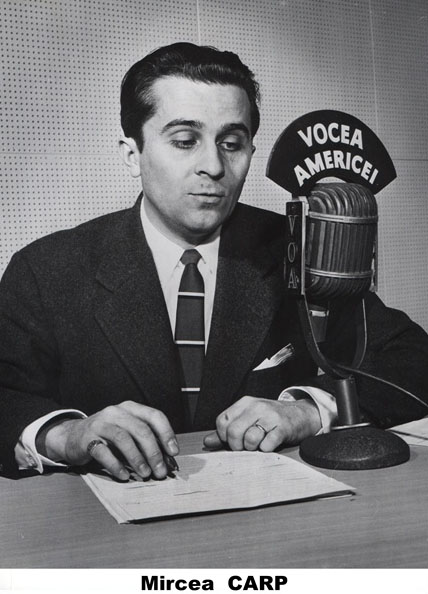The Mircea Carp Collection was created in the period 1955-1995, while its founder worked for the Voice of America radio station and, after 1979, for Radio Free Europe. Mircea Carp preserved most of the items which make up his collection out of his professional interests as a journalist at the two broadcasting agencies. A first category of items includes his personal notes used to prepare radio programmes or articles, audio recordings of programmes or interviews, excerpts from the press of the time used as sources of documentation for radio programmes or articles, official accreditation documents as journalist, reports on certain events. Another category of items consists of documents which reflect the journalist’s private life, such as his correspondence with cultural personalities of the time or family pictures. The documents were organised by Mircea Carp starting from certain key topics or important historical events. For example, some files contain his correspondence with Romanian personalities living in Romania or in exile; others refer to the visits of American presidents to Romania, or copies of letters sent from Romania to Voice of America or RFE. Some of the documents in this collection are copies, whose originals may be found either in the Open Society Archives, Budapest, or in the National Archives, Washington, DC. However, their presence in a Romanian institution is very important from the point of view of their social impact, because they offer easy access without additional costs to all interested researchers in Romania.
The Mircea Carp Collection illustrates the role played by Voice of America and RFE in receiving and transmitting several documents written by Romanian intellectuals living in Romania that were critical of the Romanian communist regime. Without the mediation of these two institutions, these documents would have remained unknown because the communist regime exercised a very strict control over all the internal means of information. In the absence of samizdat, the broadcast of these letters by the two radio stations represented the only way Romanian citizens could express their critical positions towards the communist regime. For this reason, the editors of the political programmes of the above-mentioned radio stations were perceived by the communist regime in Romania as enemies and traitors. The Carp Collection also reflects the fact that the news delivered by the programmes of the two radio stations represented the main alternative to the official sources of information controlled by the communist regime. For example, the Carp Collection shows the way in which the radio station Voice of America presented the 1977 earthquake in Romania. Another topic well represented in the documents of the Carp Collection is the Romanian exile in the period 1955–1989.
In 1995, Mircea Carp donated the collection now named after him to Lucian Blaga Central University Library Cluj-Napoca (BCU Cluj-Napoca). The Library preserved the organisation of the documents in thematic files, a system adopted by Carp before the collection was transferred. The collection was inventoried and gradually made available to the general public. The Carp Collection has been researched especially by historians and philologists interested in the history of the Romanian exile or in Carp’s correspondence with Romanian intellectuals. Ionuţ Costea, an employee of the Special Collections Department of BCU Cluj-Napoca and Associate Professor at Babeş-Bolyai University of Cluj-Napoca, published in 1997 a description of the archive in the Carp Collection in Philobiblon: Transylvanian Journal of Multidisciplinary Research in Humanities. A number of documents in the Carp Collection were used in organizing several exhibitions by BCU Cluj-Napoca in the period 2001–2005. The documents in the Carp Collection were made most visible by the creator of the collection himself. In 2013, Carp published at Polirom Publishing House a volume of memoirs entitled Aici Mircea Carp, să auzim numai de bine! (This is Mircea Carp, wishing you all the best!), the expression he used at the end of his radio programmes at RFE. The book includes a series of documents from the collection transferred to BCU Cluj-Napoca, which illustrate the events related by the author throughout the volume.

